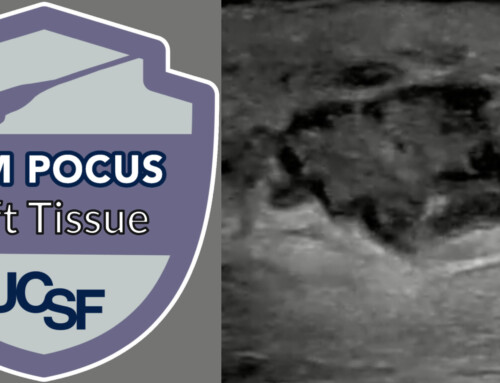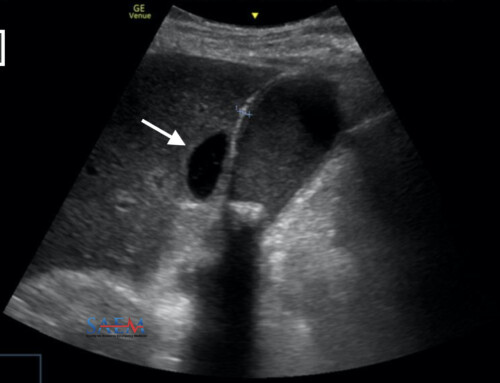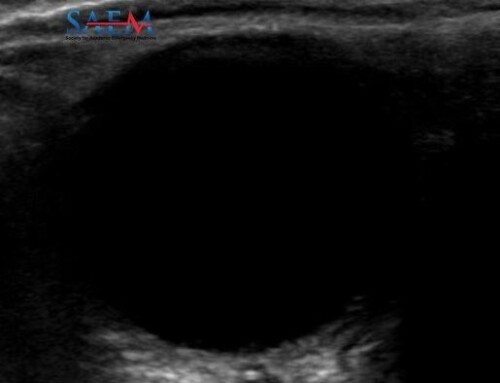Welcome to another ultrasound-based case, part of the “Ultrasound For The Win” (#US4TW) Case Series. In this peer-reviewed case series, we focus on real clinical cases where bedside ultrasound changed management or aided in diagnoses. In this case, a 46-year-old woman presents with history of right-sided abdominal pain and vomiting.
Case Presentation
A 46-year-old obese woman presents to the ED with three hours of non-bilious emesis and right-sided abdominal pain. She has been unable to eat secondary to pain. On examination, she appears in moderate distress, and has diffuse abdominal tenderness to palpation, worst at the right upper quadrant without rebound or guarding.
Vitals
| BP | 127/77 mmHg |
| P | 112 bpm |
| RR | 20 breaths/min |
| O2 | 99% room air |
| T | 36.6 C |
Differential Diagnoses
- Appendicitis
- Cholangitis
- Cholelithiasis
- Cholecystitis
- Choledocolithiasis
- Gastritits
- Pancreatic mass
- Pancreatitis
- Peptic ulcer disease
- Pregnancy
- Viral syndrome
Initial Workup
Computed tomography (CT) of the abdomen and pelvis with intravenous (IV) contrast was obtained and the radiology report was read as normal.
Labs:
- White blood cells: 10.4 cell/hpf
- Total bilirubin: 1.6 mg/dL
- Direct bilirubin: 1.2 mg/dL
- Alkaline phosphatase: 274 U/L
- Alanine aminotransferase (ALT): 464 IU/L
- Aspartate aminotransferase (AST): 447 IU/L
- Urinalysis: Negative for pregnancy, leukocytes, nitrites, white blood cells, and red blood cells
Given the ongoing concern for potential gallbladder pathology, a point-of-care ultrasound was performed.
POINT-OF-CARE ULTRASOUND was performed which showed the following:

Image 1. Point-of-care ultrasound of the gallbladder shows a large stone in the gallbladder neck (Stone-in-Neck sign), concerning for acute cholecystitis.

Image 2. The Stone-in-Neck sign: An immobile hyperechoic stone (blue arrow) seen in the gallbladder neck with posterior shadowing (#)
The images in this case demonstrate a stone lodged in the neck of the gallbladder – also known as the “Stone-in-Neck” sign.1 A large hyperechoic stone is seen with posterior shadowing. Rolling the patient to left and right lateral positions may be necessary to distinguish between a mobile versus a non-mobile stone in the neck. A SIN sign is highly suggestive of cholecystitis, and has been found to be 97% specific.1
Ultrasound Image Quality Assurance (QA)
Point-of-care ultrasonography of the gallbladder is one of the more challenging bedside studies to perform. This study is ideally performed with the curvilinear probe; the lower frequency of this probe allows for greater penetration that can be helpful, especially in obese patients. There are a few ways to identify the gallbladder; one way is to start in a sagittal plane at the subxiphoid and slide the probe inferiorly and to the patient’s right just below the costal margin. Another technique is to start at the mid-axillary line on the patient’s right side in a coronal orientation, similar to a FAST study. Having the patient take a breath in and holding it, or turning them onto their left lateral side may also optimize positioning to help to visualize the gallbladder.
Once visualized, the gallbladder anatomy should be identified including the fundus, body, and neck. As is the case with most point-of-care ultrasounds, you should obtain images in two planes to avoid missing potential pathology. The main lobar fissure (MLF), seen as a bright hyperechoic line, is a landmark that allows for identification of the portal triad, and together has the appearance of an exclamation point.

Image 3. Landmarks for the gallbladder (GB) include the main lobar fissure (blue arrow) which extends from the GB to the portal triad (*)
The next step is to visualize potential gallbladder pathology including cholelithiasis or acute cholecystitis.
The 4 sonographic signs of cholecystitis are:
- Gallstones/sludge – Visualized as hyperechoic structures within the gallbladder with posterior shadowing
- Thickened gallbladder wall – Greater than 4 mm. Of note, the anterior, not posterior wall, should be measured to avoid overestimating of the wall due to artifacts off the posterior wall.
- Pericholecystic fluid – Seen as an anechoic stripe surrounding the gallbladder
- Sonographic Murphy Sign – There is a positive Murphy Sign when pressure placed on the visualized gallbladder with the ultrasound probe reproduces the pain.
Although all four signs are not needed to make a diagnosis of cholecystitis, the presence of all four signs is very specific for cholecystitis. Concurrently, each sign seen independently is non-specific and should be taken into context with the clinical scenario.

Image 4. Sonographic signs of acute cholecystitis. Gallbladder with a hyperechoic stone and wall thickening with pericholecystic fluid (blue arrow).
Disposition and Case Conclusion
General surgery was consulted given the concerning findings on ultrasound, and she was admitted to the hospital for further management.
Point-of-care ultrasonography of the right upper quadrant is an important skill for the emergency physician (EP) to have. The initial CT scan was read as negative, and if the EP had been falsely reassured by that and discharged the patient, it would have likely led to a bad outcome.
This case highlights the fact that ultrasonography is superior to CT for the evaluation of gallbladder pathology; while the CT scan revealed no evidence of cholelithiasis or cholecystitis, the point-of-care ultrasound revealed a large stone in the neck (“Stone-in-Neck sign”) which is highly suggestive for cholecystitis. Ultrasonography has been shown to be more sensitive for the identification of cholelithiasis and cholecystitis. CT imaging is 79.1% sensitive and 100% specific for cholelithiasis,2 compared with 88% sensitivity and 87% specificity with ED-performed point-of-care ultrasonography.3
As radiology-performed ultrasound may be limited or unavailable at smaller community EDs, it is important for the EP to have the skills to identify acute cholecystitis on point-of-care ultrasound. EP-performed ultrasonography for the diagnosis of acute cholecystitis has been shown in a prospective study to be not significantly different from radiology-performed ultrasound (87% sensitive and 82% specific for ED ultrasound, compared with 83% sensitive and 86% specific for radiology ultrasound) using pathology specimens as the gold standard.4
Take-Home Points
- Point-of-care ultrasonography of the right upper quadrant is an essential skill for the emergency physician. It is more sensitive than CT for evaluation of gallbladder pathology.
- Sonographic findings of cholecystitis include:
- Gallstones/sludge
- Thickened gallbladder wall
- Pericholecystic fluid
- Sonographic Murphy Sign
- The Stone-in-Neck sign, visualization of an immobile stone lodged in the neck of the gallbladder, is highly suggestive of acute cholecystitis, with 97% specificity.1



